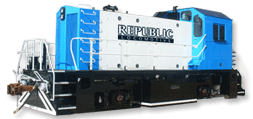TRACTIVE EFFORT CALCULATIONS
The tractive effort required to move a train consists of numerous factors, but for most applications only four need to be considered. First, a force of 2 to 5 pounds per ton of train weight is required to move on straight level track. At very slow yard speeds only 2 to 3 pounds is needed while increasing to about 5 pounds at higher speeds. This force is required to overcome bearing friction, rail deflection, minor flange contact, etc. Years ago, the initial starting requirements were much higher when cars had friction bearings. Today, with all roller bearing journals, this is not much of a consideration. At speeds above 30 to 40 miles per hour, air resistance becomes significant but since this depends on the aerodynamics of specific trains, it is not addressed here.
The second factor to consider is track curvature. Cars in a curve require a good deal of tractive effort because the wheels are mounted on solid axles. Thus the wheels must slip and slide through the curve because of the difference in radius of the inside and outside rails. Wheel flange contact adds additional friction.
For the cars in the curve, the tractive effort required is 0.8 pounds per ton per degree of curvature, where curvature is defined as the number of degrees the track curves per 100 feet. Degree of curvature can be calculated if the curve radius is known by dividing 5730 feet by the radius. For instance, track with a 573 foot radius would have 10° of curvature. Curvature can also be directly measured by the following method: Stretch a cord or tape tight across two points on the rail which are 62 feet apart. Measure the distance from the midpoint of the cord to the rail. This distance in inches is equal to the degrees of curvature.
Good engineering practice limits maximum curvature to about 12°. However, curvature may exceed 20° in an industrial yard with limited real estate, but excessive wheel and rail wear will likely result.
The percent of grade is perhaps the most important factor governing tractive effort. For every ton of train weight in a grade, 20 pounds of tractive effort is needed for each 1% of slope. (One percent of a ton or 2000 pounds equals 20 pounds.) A 1% grade is defined as a vertical increase of one foot for each 100 feet of horizontal distance. A 1% grade is considered steep; a 2% grade is unusually steep.
The final factor and one frequently overlooked is the tractive effort required for acceleration of the train. It takes about 10 pounds per ton to accelerate to a speed of 6 miles per hour in one minute or 12 miles per hour in two minutes, a reasonable rate for a heavy train. Increasing this tractive effort increases the acceleration rate proportionately.
The total tractive effort required for a train is the sum of these four components. The individual components will vary for any point on a rail system depending on the load in a curve or on a grade and whether acceleration is required at that point.
A train may be able to get a “running start” at a hill. The kinetic energy in the train can be converted to elevation using the formula:
S²/30= H
Where S is speed in miles per hour and H is elevation in feet.
POWER CALCULATIONS
The Power required to move a train is defined by a simple formula:
P=TS/375
Where P is power in horsepower at the rails, T is tractive effort in pounds and S is speed in miles per hour. The engine horsepower at the flywheel is reduced by the auxiliaries such as air compressor, cooling fan, charging alternator, traction generator and motor losses, drive losses, and gearing losses. The net effect of these losses is to reduce power to the rail by 20% to 30%. About 80% of the rated engine power is available at the rail for a modern AC traction locomotive versus about 70% for the older DC units.
Most yard switching applications seldom exceed about 30,000 pounds of tractive effort and speeds of 5 to 7 miles per hour. Therefore the industrial locomotive will perform well with 500 to 600 horsepower. A short line railroad or branch line with the same tractive effort requirements might require up to 2000 horsepower to move the train because of the higher speeds involved. Main line locomotives may need over 4000 horsepower each with multiple units because of both high tractive effort and speeds.


